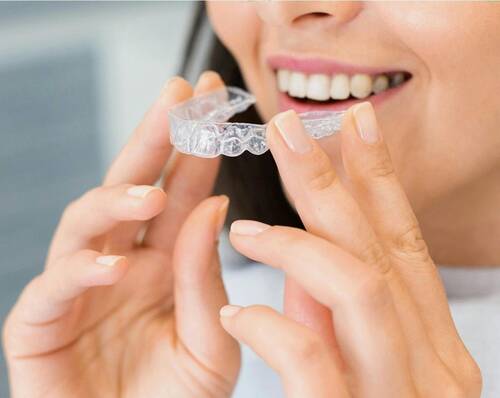
23 Oct 5 Common Misconceptions About Invisalign Treatment
Are you considering Invisalign treatment but finding yourself a bit hesitant due to some of the things you’ve heard? Many people have a few misconceptions about Invisalign, and that’s totally understandable. Dental treatments can seem intimidating if you’re not familiar with how they work. But once you’ve got the right information, it’s easier to feel confident about making a choice that suits your smile.
Invisalign is one of the most popular options for straightening teeth today, yet there are still some lingering myths surrounding it. By the end of this post, you’ll have a clearer picture of what Invisalign is really about.
1. Invisalign Is Only for Minor Corrections
One of the most common misconceptions out there is that Invisalign is only suitable for minor corrections. While Invisalign is great for those small adjustments, it’s also highly effective for more complex orthodontic issues. From overbites to underbites, crossbites to crowded teeth, Invisalign can handle quite a range of dental concerns.
You may wonder: “But how can clear trays fix something more severe?” The answer lies in the advanced technology behind the treatment. Invisalign uses a series of custom-made aligners that gradually move your teeth into their ideal position. The process is just as thorough as traditional braces but without the metal brackets and wires.
2. It Takes Longer Than Traditional Braces
Have you heard that Invisalign takes longer to straighten teeth than traditional braces? If so, let’s clear that up right now. In many cases, Invisalign can actually work faster than metal braces. The average treatment time for Invisalign is between 12 and 18 months, depending on your unique case. For some people, it might even be shorter, so you might consider Invisalign treatment for your best smile faster.
Why does Invisalign sometimes take less time? Unlike braces, which rely on adjustments made by your orthodontist every few weeks, Invisalign aligners are swapped out every 1 to 2 weeks, keeping your teeth moving along continuously. This constant movement can reduce the overall treatment time for many patients.
Of course, how long treatment takes will depend on the complexity of your case and, importantly, how well you stick to wearing your aligners. (Yes, that 22 hours a day recommendation is crucial!) So, no, Invisalign doesn’t always mean a longer journey to a straighter smile—it could actually be quicker.
3. You Can Eat Anything You Want With Invisalign On
This one’s a little tricky, and while it sounds tempting, it’s not entirely true. You do have a bit more freedom with Invisalign compared to traditional braces, but there are still some guidelines to follow. You can technically eat anything you want, but here’s the catch: you must take your aligners out before eating.
Once you remove them, there are no food restrictions, unlike braces, where sticky or hard foods can be problematic. After eating, it’s important to brush your teeth before popping the aligners back in. This simple routine helps keep your aligners clear and your teeth healthy.
So, while you’re not limited to soft foods or cutting back on your crunchy favorites, you still need to be mindful about when and how you eat with Invisalign. It’s a bit of a balance, but one many people find worth it for the added convenience.
4. Invisalign Is More Expensive Than Braces
Here’s a myth that often gives people pause: the idea that Invisalign is far more expensive than traditional braces. The reality? It really depends. The cost of Invisalign and braces is often comparable. In fact, in many cases, the prices aren’t that different at all.
Several factors play into the cost, including the complexity of your treatment and the duration. Most orthodontists offer flexible payment plans, and many insurance providers cover Invisalign the same way they do braces. So, if you’re worried about costs, it’s worth talking to your orthodontist to get a clear understanding of what your treatment will cost and what payment options are available to you.
In other words, don’t let the fear of higher costs scare you away from considering Invisalign. With a bit of research, you might find it’s more affordable than you expected.
5. Invisalign Is Painful
Let’s be honest—anything that involves moving your teeth is going to come with a little discomfort. But painful? Not really. Invisalign is designed to be more comfortable than traditional braces. There are no wires or brackets that can poke your gums or cheeks, which is a common complaint with metal braces.
With Invisalign, you might feel some pressure when you switch to a new set of aligners, but this is a sign that the treatment is working. Most people report that the discomfort is minimal and fades after a day or two. Plus, the smooth plastic aligners are far gentler on your mouth than the hardware of traditional braces.
If you’re worried about pain, remember that any orthodontic treatment will come with some level of adjustment, but Invisalign tends to be one of the more comfortable options available.
Whether you’re concerned about cost, comfort, or the complexity of your case, Invisalign could be the perfect solution for achieving the smile you’ve always wanted.
———————————-
The information on MedicalResearch.com is provided for educational purposes only, and is in no way intended to diagnose, cure, or treat any medical or other condition.
Some links are sponsored. Products, services and providers are not tested, warranted or endorsed.
Always seek the advice of your physician or other qualified health and ask your doctor any questions you may have regarding a medical condition. In addition to all other limitations and disclaimers in this agreement, service provider and its third party providers disclaim any liability or loss in connection with the content provided on this website.
Last Updated on October 23, 2024 by Marie Benz MD FAAD
